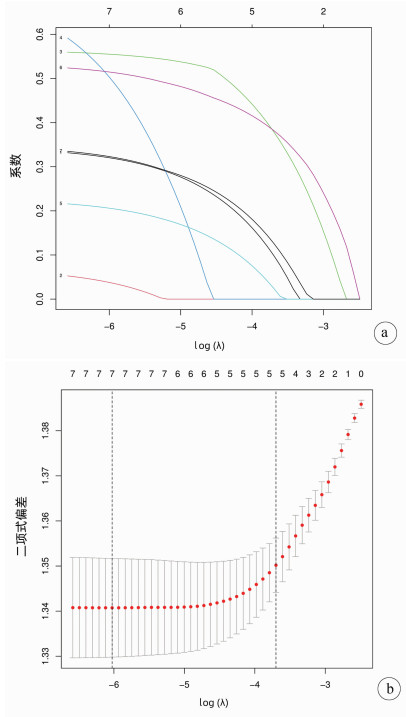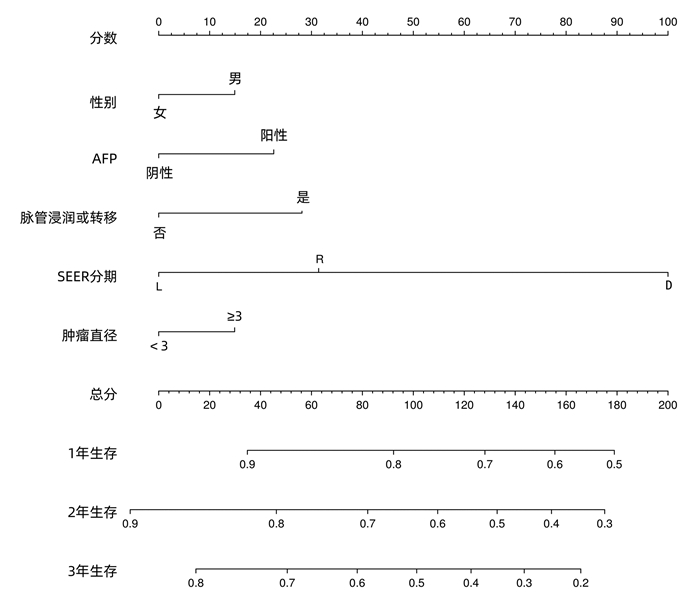| [1] |
TORRE LA, BRAY F, SIEGEL RL, et al. Global cancer statistics, 2012[J]. CA Cancer J Clin, 2015, 65(2): 87-108. DOI: 10.3322/caac.21262. |
| [2] |
WEN T, JIN C, FACCIORUSSO A, et al. Multidisciplinary management of recurrent and metastatic hepatocellular carcinoma after resection: An international expert consensus[J]. Hepatobiliary Surg Nutr, 2018, 7(5): 353-371. DOI: 10.21037/hbsn.2018.08.01. |
| [3] |
AHN KS, KANG KJ. Appropriate treatment modality for solitary small hepatocellular carcinoma: Radiofrequency ablation vs. resection vs. transplantation?[J]. Clin Mol Hepatol, 2019, 25(4): 354-359. DOI: 10.3350/cmh.2018.0096. |
| [4] |
LI CH, HU P, OU YJ, et al. Development and validation of nomogram for predicting survival outcomes in patients with small hepatocellular carcinoma[J]. J Third Mil Med Univ, 2020, 42(20): 2046-2056. DOI: 10.16016/j.1000-5404.202007005. |
| [5] |
ZHANG W, WANG X, JIANG R, et al. Effect of tumor size on cancer-specific survival in small hepatocellular carcinoma[J]. Mayo Clin Proc, 2015, 90(9): 1187-1195. DOI: 10.1016/j.mayocp.2015.06.018. |
| [6] |
WEI Y, DAI F, YI Y, et al. Impact of local tumor lesion treatments and preoperative indicators on the survival of patients with small hepatocellular carcinomas[J]. Oncol Lett, 2018, 16(4): 5050-5058. DOI: 10.3892/ol.2018.9263. |
| [7] |
VOLK ML. Unfair priority for HCC: A problem whose ideal solution remains unsolved[J]. Am J Transplant, 2010, 10(7): 1507-1508. DOI: 10.1111/j.1600-6143.2010.03154.x. |
| [8] |
ZANG YY, LONG PY, HAN ZW, et al. Establishment and verification of a nomogram for predicting patient prognosis after hepatectomy for hepatocellular carcinoma[J]. J Clin Hepatol, 2019, 35(10): 2225-2230. DOI: 10.3969/j.issn.1001-5256.2019.10.019. |
| [9] |
SALVATORE M, JEON J, MEZA R. Changing trends in liver cancer incidence by race/ethnicity and sex in the US: 1992-2016[J]. Cancer Causes Control, 2019, 30(12): 1377-1388. DOI: 10.1007/s10552-019-01237-4. |
| [10] |
BALACHANDRAN VP, GONEN M, SMITH JJ, et al. Nomograms in oncology: More than meets the eye[J]. Lancet Oncol, 2015, 16(4): e173-e180. DOI: 10.1016/S1470-2045(14)71116-7. |
| [11] |
JADLOWIEC CC, TANER T. Liver transplantation: Current status and challenges[J]. World J Gastroenterol, 2016, 22(18): 4438-4445. DOI: 10.3748/wjg.v22.i18.4438. |
| [12] |
SUNG H, FERLAY J, SIEGEL RL, et al. Global cancer statistics 2020: GLOBOCAN estimates of incidence and mortality worldwide for 36 cancers in 185 countries[J]. CA Cancer J Clin, 2021, 71(3): 209-249. DOI: 10.3322/caac.21660. |
| [13] |
|
| [14] |
CHEN K, HUO RR, CHEN SY, et al. Analysis of the relationship between gender and prognosis of patients after liver resection for hepatocellular carcinoma[J]. Chin J Hepatobiliary Surg, 2020, 26(5): 330-334. DOI: 10.3760/cma.j.cn113884-20190909-00290. |
| [15] |
GALLE PR, FOERSTER F, KUDO M, et al. Biology and significance of alpha-fetoprotein in hepatocellular carcinoma[J]. Liver Int, 2019, 39(12): 2214-2229. DOI: 10.1111/liv.14223. |
| [16] |
ZHU Y, XIA QQ, LUO J, et al. Application of combined detection of alpha-fetoprotein, alpha-fetoprotein heterogeneity and TNF-α factor in the diagnosis of primary liver cancer and its clinical value[J]. J Clin Exp Med, 2020, 19(4): 383-386. DOI: 10.3969/j.issn.1671-4695.2020.04.014. |
| [17] |
GRAHAM JA, MELANCON JK, SHETTY K, et al. Liver transplantation should be offered to patients with small solitary hepatocellular carcinoma and a positive serum alpha fetoprotein rather than resection[J]. Am J Surg, 2013, 205(4): 374-380. DOI: 10.1016/j.amjsurg.2012.12.002. |
| [18] |
TANG H, TANG XY, LIU M, et al. Targeting alpha-fetoprotein represses the proliferation of hepatoma cells via regulation of the cell cycle[J]. Clin Chim Acta, 2008, 394(1-2): 81-88. DOI: 10.1016/j.cca.2008.04.012. |
| [19] |
LU Y, ZHU M, LI W, et al. Alpha fetoprotein plays a critical role in promoting metastasis of hepatocellular carcinoma cells[J]. J Cell Mol Med, 2016, 20(3): 549-558. DOI: 10.1111/jcmm.12745. |
| [20] |
ZHANG XP, CHEN ZH, ZHOU TF, et al. A nomogram to predict early postoperative recurrence of hepatocellular carcinoma with portal vein tumour thrombus after R0 liver resection: A large-scale, multicenter study[J]. Eur J Surg Oncol, 2019, 45(9): 1644-1651. DOI: 10.1016/j.ejso.2019.03.043. |
| [21] |
WANG Y, SUN K, SHEN J, et al. Novel prognostic nomograms based on inflammation-related markers for patients with hepatocellular carcinoma underwent hepatectomy[J]. Cancer Res Treat, 2019, 51(4): 1464-1478. DOI: 10.4143/crt.2018.657. |
| [22] |
|
| [23] |
LU XY, XI T, LAU WY, et al. Pathobiological features of small hepatocellular carcinoma: Correlation between tumor size and biological behavior[J]. J Cancer Res Clin Oncol, 2011, 137(4): 567-575. DOI: 10.1007/s00432-010-0909-5. |
| [24] |
MINAGAWA M, IKAI I, MATSUYAMA Y, et al. Staging of hepatocellular carcinoma: Assessment of the Japanese TNM and AJCC/UICC TNM systems in a cohort of 13, 772 patients in Japan[J]. Ann Surg, 2007, 245(6): 909-922. DOI: 10.1097/01.sla.0000254368.65878.da. |
| [25] |
ZHOU DD, LIU XL, JIANG TT, et al. Analysis and comparison of common prognostic prediction models for liver cancer[J]. Chin J Clin Oncol, 2020, 47(24): 1281-1286. DOI: 10.3969/j.issn.1000-8179.2020.24.149. |
| [26] |
WEN L, WENG S, YAN C, et al. A radiomics nomogram for preoperative prediction of early recurrence of small hepatocellular carcinoma after surgical resection or radiofrequency ablation[J]. Front Oncol, 2021, 11: 657039. DOI: 10.3389/fonc.2021.657039. |
| [27] |
ZHOU ZW, LIU YC, XIANG BD, et al. Global outlook for primary liver cancer: Prevalence, risk, factors and population attribution scores[J]. Chin J Oncol Prev Treat, 2021, 13(1): 14-21. DOI: 10.3969/j.issn.1674-5671.2021.01.03. |















 DownLoad:
DownLoad:


